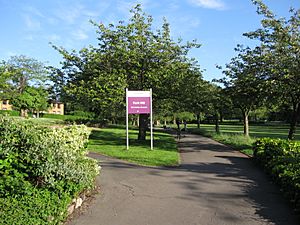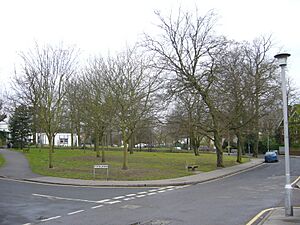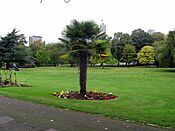Park Hill Recreation Ground facts for kids
Quick facts for kids Park Hill |
|
|---|---|

Park Hill Recreation Ground entrance from Central Croydon side
|
|
| Lua error in Module:Location_map at line 420: attempt to index field 'wikibase' (a nil value). | |
| Type | Public park |
| Location | Croydon |
| Operated by | London Borough of Croydon |
| Status | Open all year (closed at night) |
| Public transit access | East Croydon station, South Croydon railway station London Buses, route 64; route 433 to Birdhurst Gardens stop. |
Park Hill Recreation Ground is a large park, about 15 acres (that's like 11 football fields!). It's located near the center of Croydon, in Greater London. The London Borough of Croydon looks after this park. You can find it stretching from Barclay Road to Coombe Road, right next to the railway line. The main entrances are on Water Tower Hill and Barclay Road.
The closest train stations are East Croydon (for Tramlink and trains) and South Croydon (for trains). Both are about the same distance from the park. The park was officially given its current name, Park Hill, in 1964.
At the very top of the hill, at the park's southern end, you'll find the old grounds of Coombe Cliff. This used to be the home of the Horniman Tea family. A steep path winds down from there to Coombe Road. This path leads to South Croydon railway station. The old grounds are now part of the park and are open to everyone, but the house itself is not. As of October 2018, the house is used for school activities. There's also an old gatehouse near Coombe Road, which is now a private home. The main house is a Grade II listed building, meaning it's historically important.
Before it became a park, this area was a big water storage tank called a reservoir. In the 1880s, it was changed into the public park we see today. Park Hill offers cool things like places to get snacks, sports areas, and a special garden filled with herbs.
A famous writer named Malcolm Muggeridge wrote in his book, "The Chronicles of Wasted Time" (1973), that Park Hill was his childhood playground. He remembered walking there often with his dad, talking about big ideas like socialism and world events.
Contents
Discover Park Hill's Past
How Park Hill Began
Park Hill Recreation Ground is actually a small piece of a much bigger old park. This huge park belonged to the Archbishop of Canterbury and was called Croydon Park. It was enormous, about 210 acres, and might have looked like a nature reserve. We know it existed as far back as the 1300s. In 1382, a person named Sir William Walworth was in charge of looking after it.
Later, in 1540, the park was given to Henry VIII as part of a trade for other lands. But after the King died, it went back to Archbishop Cranmer. By the 1700s, the Archbishop's main home, Croydon Palace, was not used anymore and was falling apart. So, in 1726, the park was rented out to William Busick. It was then turned into farmland.
The Giant Water Tank
In 1850, the Archbishop agreed to sell a small part of the land to Croydon's local health group. They wanted to build a reservoir there. A reservoir is like a giant tank that holds water. This one was a huge brick cylinder, about 75 feet wide and 50 feet tall, with a domed roof. It had strong walls and was covered with thick earth to keep the water cool.
The reservoir was designed by William Ranger and built by William Harris. Water was pumped from a well at the new Surrey Street pumping station into this reservoir. This gave the town a steady supply of fresh, piped water. The Archbishop John Bird Sumner officially opened the pumping station and reservoir on December 11, 1851. People even went down into the empty reservoir by candlelight to see the water arrive!
This reservoir could hold 900,000 gallons of water. It was thought to be enough water for the town for about 18 days. However, the town grew quickly, and by 1866, people were using 1.5 million gallons daily. Even though it was useful, the reservoir couldn't keep up with the demand. It became less important when a new reservoir, the Russell Hill reservoir, opened in 1923.
During World War II, even though it leaked, the Park Hill reservoir was kept full. This was in case firefighters needed water. The old reservoir is still there, without its roof, under a mound of earth near the water tower. Its domed roof was taken down in 1971 because it wasn't safe anymore.
People often visited this "Reservoir Hill," even before it was a park. There was a path called Lover's Walk, which is now part of Chichester Road.
The Croydon Water Tower
The park is also home to the historic Croydon Water Tower. This tower helped supply water to the highest parts of the town. It was built in 1867 by John Thomas Chappell. The tower is 125 feet tall and made of brown and red bricks.
Inside, there was a large brick tank that held 94,000 gallons of water. Water was pumped from the reservoir to a smaller iron tank at the very top of the tower. A steam engine, located in a nearby building, powered this pump.
The water tower stopped being used for water supply around 1923. This was because a new well and reservoir in Addington could supply water to Croydon's high areas. As of September 2015, the tower is a Grade II listed building, but it's not used and you can't go inside. However, for a few years starting in 1889, the tower was open to the public in the summer. People could pay a penny to go up and enjoy the views!
The building that held the steam engine was taken down in the 1950s. The iron tank at the top of the tower was removed in 1971.
Becoming a Public Park
People realized that towns needed more public green spaces. After many talks that started in 1880, the local government of Croydon bought 8 acres of Park Hill. This happened on February 17, 1887, and cost £4,000. The land stretched from Fairfield Road to Coombe Cliff.
A very important rule of the sale was that this land had to stay a public park forever. It also needed fences and a new road on its northern side. This meant about £2,000 had to be spent on the park. This money paid for grass, planting trees, and paved paths. The park was designed by Mr. Powell, the town's road surveyor. Work began at the end of 1887.
The Park Hill Recreation Ground officially opened on July 11, 1888. Soon after, 40 seats were added for visitors. A local council member, F T Edridge, even donated a bandstand in 1889. As mentioned before, the park became even bigger in 1930 when the grounds of Coombe Cliff were added.
Cotelands
Cotelands is a small park very close to Park Hill. It's also managed by the London Borough of Croydon. This little green space is about 0.20 hectares in size. It's basically a grassy area on the corner of Cotelands and The Avenue. You can find it next to Park Hill Junior School and near Archbishop Tenison's School.
Gallery






